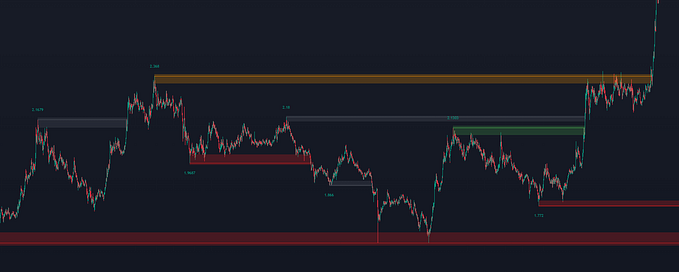How Interport enhances USDC to be the core cross-chain asset

CCTP Overview and Arbitrum launch
A quick reminder what is CCTP:
The Cross-Chain Transfer Protocol (CCTP) is an open on-chain tool that has the capacity to extinguish native USDC on one blockchain and create an equivalent amount of native USDC on a target blockchain. This sets up the groundwork for a consolidated and widely adopted Web3.
The beauty of native USDC enables protocols for almost unlimited cross-chain liquidity on all supported chains, which hence creates various opportunities.
So far CCTP was operating on Ethereum and Avalanche, but recently launched services on Arbitrum.
We strongly believe that in the “right hands” this can become an unified tool for absorbing the majority of cross chain trading volumes and simplifying the experience for users.
Arbitrum is a Layer 2 enhancement for the Ethereum blockchain, specifically developed to enhance transaction speed, bolster scalability, and amplify privacy within the network. It facilitates users in executing transactions away from the primary network, which are then authenticated and bundled together before being re-integrated into the main chain.
Currently there are various protocols and decentralized financial activity going on Arbitrum, hence native USDC liquidity will definitely be in demand!
Interport overview
As a decentralized cross-chain exchange, Interport operates through the most efficient routing and execution. In other words Interport finds the best price on a specific chain and executes cross chain transactions.
While operating the cross-chain transaction, assets from the source chain always get swapped for native USDC. Using CCTP, USDC becomes available at the destination chain, it gets swapped for desired assets via liquidity aggregation, hence allows for the best execution rate for users.
In order to speed up transactions and make sure the cross-chain slippage will be minimized, Interport can use its own USDC pools to execute transactions. CCTP in that case, helps to perform cross-chain pool rebalances and sustain efficient liquidity on all supported chains.
Interport also introduces the automation for CCTP, that would result in a simple one click bridge of USDC for users. With zero fees, users will just cover network gas costs and be able to receive USDC on all supported chains.
The advent of Interport’s cross-chain aggregation and optimal swaps, combined with the limitless liquidity offered by CCTP across networks, opens up an entirely new range of possibilities for protocols and DeFi. As a result, all trading or swap activities have the potential to become genuinely interchain, rather than being restricted to the liquidity of a single network.
Synergy of Interport and CCTP
Currently there are several problems across DeFi:
- Liquidity fragmentation
- Unoptimised cross-chain routing
- Demand for chain native stable liquidity
Such issues create additional barriers for protocols and users across Web3 space and require fundamental solutions. Removing such barriers will evolve Web3 space and allow for even faster development and growth in usage and adoption.
Circle’s Cross-Chain Transfer Protocol (CCTP) and Interport present several key synergies that make them powerful tools for the emerging Web3 ecosystem.
CCTP’s focus on allowing developers to efficiently move USDC across different chains is in itself a crucial utility that streamlines the often complex process of cross-chain transfers. Coupling this with Interport’s decentralized exchange functionality could potentially lead to an even more seamless, user-friendly experience for people operating in multi-chain environments.
Interport’s advanced liquidity aggregation from various decentralized exchanges could ensure that users always get the best rates for their cross-chain swaps. This means that the integration of CCTP into Interport could not only facilitate the movement of USDC between chains but also optimize the rates of exchange, resulting in enhanced capital efficiency.
Furthermore, it would contribute to the ease of cross-chain operations, eliminating the need for users to manually bridge assets or search for liquidity pairs. The combination of CCTP’s simple, streamlined burning and minting process and Interport’s assurance of best prices, guaranteed through its cross-chain liquidity aggregation contracts, would provide users with a robust and efficient platform to manage their digital assets across different networks. This mutual enhancement of functionalities essentially aligns with the vision of a more interconnected, united, and accessible Web3 environment.
Routing fundamentals and how Interport enhances USDC utilization
Transactions that are aggregated prioritize the most cost-efficient execution. Ordinarily, the volumes of directional liquidity pools surpass those of routed liquidity pools. To illustrate, consider a scenario where you wish to purchase xToken with USDC. With automated routing, the pathway would typically be from USDC -> ETH -> xToken, which often results in a less efficient execution rate due to routing fees and liquidity fluctuations.
Moreover, if the xTokens are using specific liquidity strategies with ETH, and if the USDC/ETH pool doesn’t follow a similar approach, the inefficiency in price execution could be even more pronounced. However, a direct liquidity connection between USDC and xToken would offer a significantly improved rate. Further, protocols would have the capacity to modify their liquidity strategies.
This reasoning extends to assets native to specific chains and those with high trade volumes, such as ETH, BNB, ARB, wBTC, FTM, and others. Direct liquidity paths promise the best execution rates and enable quick single-route swaps. For example, users could swap their ARB tokens for BNB across chains without any routing, thereby avoiding any losses due to price slippage or impacts — even in cases where such a pair does not exist. Interport would facilitate this by selling a user’s ARB for USDC on the source chain and buying BNB with USDC on the destination chain, effectively creating a zero-loss swap routed via USDC.
In the broader picture, the combination of the Cross-Chain Transfer Protocol (CCTP) and Interport could significantly increase the utilization of USDC across decentralized finance (DeFi) via cross-chain swaps and routing. This method could motivate DeFi protocols to transfer their liquidity (or at least a part of it) and pair it with USDC, enabling zero-loss routing and increasing their trading volumes across all chains.
In summary, CCTP represents a significant advancement for USDC. Its integration with Interport could form the backbone of USDC’s growth as the most traded token in DeFi, breaking down chain-based barriers for users and broadening opportunities.
Ethereum, Arbitrum and Avalanche are already embracing interchain trends, the next question to ponder is, “Who will be the next to join the movement?”.
Try cross-chain trading powered by CCTP:








